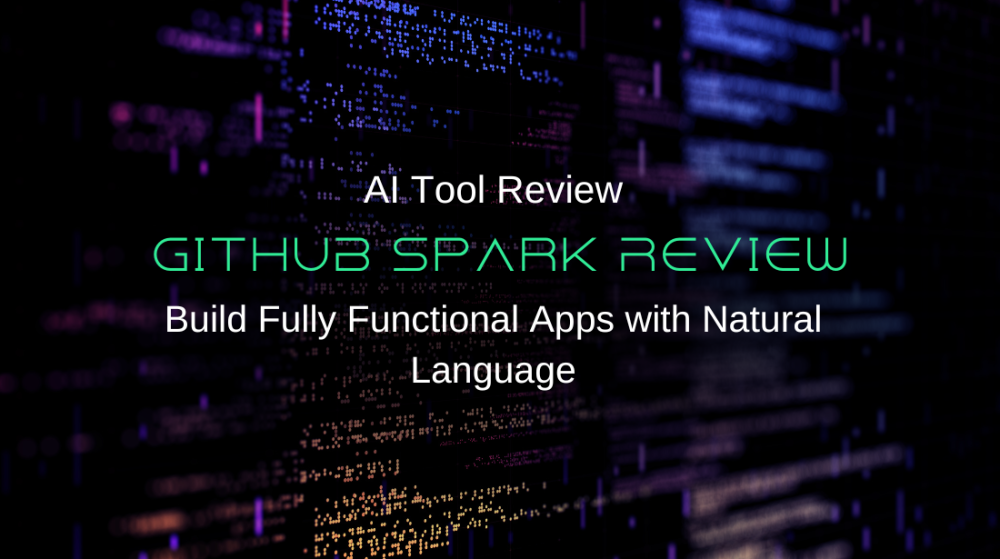GitHub Spark Review: Build Fully Functional Apps with Natural Language (No Code Knowledge Required?)
It starts with a tiny itch of an idea. You're at a café, halfway through your latte, staring at a napkin doodle: a weekly karaoke organizer that suggests songs, tracks scores, and posts results to a shared page. You open GitHub Spark.
"I need a karaoke night organizer with a leaderboard, signup form, and AI song suggestions. Make it playful."
You hit return. The screen blinks. A live app blossoms into view—polished UI, clean typography, delightful micro-interactions. It looks…done. Not "scaffolded," not "toy UI," but something you wouldn't be embarrassed to share. That's by design: Spark was trained to have taste. It favors shadcn/ui components, readable type scales, generous spacing—the small things that make software feel cared for.
You tweak a card's spacing using the little target icon. You darken the theme. You add tags. Each change materializes instantly in the preview. You save nothing—Spark remembers everything. Versions stack up like snapshots of your creative impulse. Pick one, roll back, remix. Fearless building.
GitHub Spark Development Workflow: Building Apps with Natural Language
Spark's magic isn't just speed, it's momentum. You can build from any altitude:
Say it: "Add a judging panel with emojis. Mobile-first layout. Please optimize for accessibility."
Nudge it: Click elements and adjust colors, spacing, or typography in a sidebar. Switch the global theme.
Shape it: Crack open the code—real React + TypeScript, with Copilot helping. Or jump into a Codespace for terminal power.
There's no context switching between tools, no cloud setup, no yak-shaving. You speak, it builds. You refine, it learns. You ship, it deploys. All inside GitHub's ecosystem—repos, Actions, Dependabot, Codespaces—like you never left home.
Publishing and Sharing Your GitHub Spark Apps
You click Publish. Your app gets a URL. You invite friends. Someone remixes it—forks your spark and swaps in a different model for music suggestions. Another person skins it as a movie night tool. In an afternoon, your napkin note became a miniature software universe.
And the best part? It's your code in a GitHub repo. Not a proprietary black box—actual React + TS with Vite. The "no sandbox" philosophy means you can step off the rails when you need to.
GitHub Spark Technical Architecture and Features
Behind the curtain is a thoughtful pipeline:
Contextual Copilot: Your request is enriched with app history, current code, even error logs.
Reasoning model: A large model (Spark launched with Claude Sonnet 4) figures out what to change.
Agent at work: It edits code, installs dependencies, runs commands, and tests behaviors. The only artifact is updated code.
Apps run on a managed Azure runtime. A private API (window.spark) provides data storage (key/value), GitHub auth, and access to multiple AI models without managing keys. You can export your code, but if you leave the Spark runtime you'll need to replace those APIs—think "escape hatch," not "teleporter."
GitHub Spark Target Users and Use Cases
Founders and product teams: The fastest way to validate an MVP and get feedback that matters.
Designers and PMs: Functional prototypes without waiting for sprint cycles.
Developers: A "Phase 0" accelerator that clears the boring setup and leaves you holding a real repo.
Makers, educators, and tinkerers: Joyful micro-apps that do one thing well and ship instantly.
GitHub Spark Advantages and Key Benefits
Velocity: Idea → live app in minutes. Truly.
Taste: Polished by default. Thoughtful defaults make your first draft feel premium.
GitHub-native: Repos, CI/CD, Codespaces—zero ceremony.
Creative groove: Prompt, click, code—one continuous loop.
GitHub Spark Limitations and Current Constraints
Stack lock: React + TypeScript web apps only. No Vue, Svelte, Angular. No native mobile.
SEO blind spot: Client-side rendering means poor search visibility for public sites.
Complexity ceiling: Not the tool for hairy enterprise logic or niche integrations.
Portability tax: Exportable code depends on @github/spark runtime features you'll need to rebuild elsewhere.
Quotas and cost: Part of Copilot Pro+, with Spark message limits.
GitHub Spark vs Competitors: Feature Comparison
Lovable (AI-native builder)
Spark: Frictionless startup, GitHub-native, perfect for micro-apps and prototypes.
Lovable: Heavier full-stack muscle with Supabase/Postgres and structured agents—great for SaaS.
Pick Spark for momentum and ecosystem; pick Lovable for deeper backends.
Bubble/Webflow (no-code)
Spark: Natural language to real code; great developer handoff and logic.
Bubble: Rich plugin ecosystem and granular visual control (but no code export).
Webflow: SEO powerhouse for marketing sites; limited app logic.
Choose Spark for apps, Webflow for SEO sites, Bubble for visual-first no-code.
Retool/Power Apps (internal tools)
Spark: Generalist sprinter for rapid, shareable internal tools.
Retool: Purpose-built for internal apps with robust connectors and governance.
Power Apps: Enterprise-grade, deeply integrated in Microsoft's Power Platform.
Use Spark to explore fast; use Retool/Power Apps for long-term internal systems.
Best Practices for Using GitHub Spark Effectively
Be specific: Describe data models, user journeys, states, and edge cases in your prompt.
Style with intent: Use the target tool and theme editor to nail the feel quickly.
Ask for responsiveness: Explicitly request mobile-first layouts and breakpoints.
Audit logic: Review critical paths, add tests, and watch for AI "happy path" assumptions.
Plan for portability: Abstract calls to window.spark if you might self-host later.
GitHub Spark Future Features and Roadmap
- Framework plurality (Vue, Svelte, Angular)
- Native iOS/Android generation
- SEO-friendly SSR/SSG options
- Stronger backend primitives (relational DBs, queues, auth providers)
GitHub Spark Review: Should You Use It for Your Next Project?
GitHub Spark feels like the moment software stopped asking for permission. It's the most convincing "talk it into existence" studio available—fast, tastefully opinionated, and grounded in developer reality with real code and real CI.
It won't replace complex, mission-critical builds. It will help you discover the right ideas faster than anything else. If you've got a napkin with an app on it, Spark is your green light.





